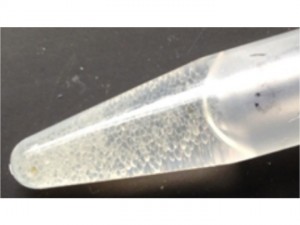Nanomaterials are fast becoming the materials of the future. Just this year three scientists were awarded the Nobel Prize in Chemistry for their work in understanding Molecular Machines. Each time period in human history has been defined by the materials that we are able to harness–the Stone Age, the Bronze Age, and now, the Nanomaterial Age? The better scientists are able to design, create, and manipulate nanoscale objects, the more advanced our technology will become.
But let’s back up a little. What is the nanoscale? You would be correct if you said really, really, really small, but let’s be more precise about it. A nanometer is 0.000000001 meters or, in scientific notation, 1 × 10-9 meters (move the decimal over 9 spaces). As you can see from the image below, you can’t see nanoscale objects with the naked eye, but they are still much bigger than individual molecules or x-rays.

As research in nanomaterials explodes across the globe, researchers at Indiana University are not missing out. IU’s Douglas Biomimetic Materials Lab studies how viruses can be hijacked to be used as functional nanomaterials that are called Virus-Like Particles (VLPs). You can read about VLPs as nanomaterials in my previous ScIU post, here. Because most viruses are tiny protein cages with the infectious molecules (either DNA or RNA) on the inside, replacing the virus’s genetic material with functional molecules opens the door for creating new nanomaterials–sneaky!
In a paper published in 2014, members of the Douglas lab showed that the enzyme NADH oxidase (NOX), which converts oxygen into hydrogen peroxide, could be contained inside a protein cage from a virus, like a bunch of coins inside a plastic Easter egg. However, the protein cages are porous and they’re about one-millionth the thickness of your fingernail.
The benefit of putting enzymes into these VLPs is that the enzyme is now protected from the environment and can be confined in a much smaller, and thus more efficient, space. But what’s useful about sticking a hydrogen peroxide (H2O2) producing enzyme inside a tiny protein cage? The researchers at IU showed that once encapsulated, the NOX enzymes could still make H2O2 and, because the VLPs are porous, the H2O2 was released into the solution. This released H2O2 was then shown to inhibit the growth of bacteria.
To test this inhibition the scientists looked at the number of E. coli bacterial cells in a sample with and without the enzyme-VLPs. This cell counting was achieved by measuring how much light passed through a solution of E. coli. As the cells multiply, the solution gets cloudier and cloudier, which prevents light from passing through. The less light that can get through the solution, the more bacterial cells there are in that solution. In experiments where enzyme-VLPs were added to a clear solution (low number of bacterial cells), the solution remained clear over an 8-hour time period meaning that the H2O2 from the enzyme was indeed inhibiting bacterial growth!

Enzyme-VLPs that inhibit bacterial growth are super cool, but because they are mixed in solution, there is no easy way of reusing them. To remedy this single-use dilemma, Douglas Lab researchers attached the enzyme-VLPs to small glass beads (left), allowing them to be separated from solutions that contain the H2O2 product. Because the VLPs are so much smaller than the glass beads, there would be hundreds or thousands of VLPs per glass bead. The study showed that the enzymes inside the VLPs not only retained their activity once attached to the glass beads, but that they could be reused–a highly desirable trait for industrial chemical production. Perhaps these enzyme-VLPs could be attached to medical devices or other equipment in which sterilization is crucial.
As our understanding of how molecules behave on the nanoscale increases, so will our ability to manipulate them. By taking inspiration from and building on the complexity of nature, we may very well be entering the Nanomaterial Age.
Edited by Clara Boothby and Guillaume J. Dury

very informative posts
Fascinating read! Your explanation of the interaction between nanomaterials and bacteria is truly captivating. Excellent job on making science so engaging and accessible!